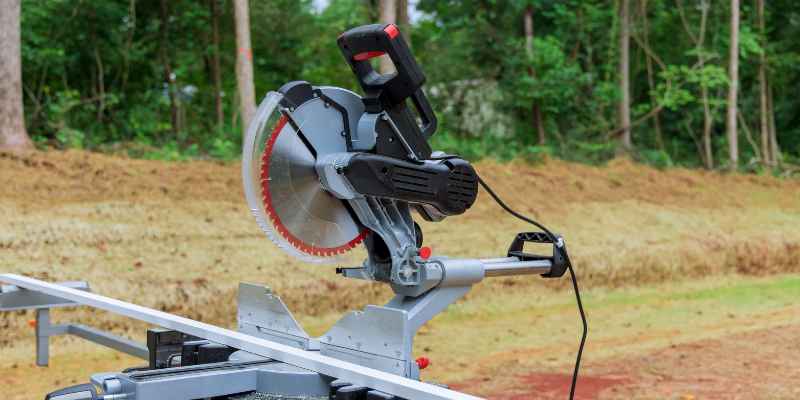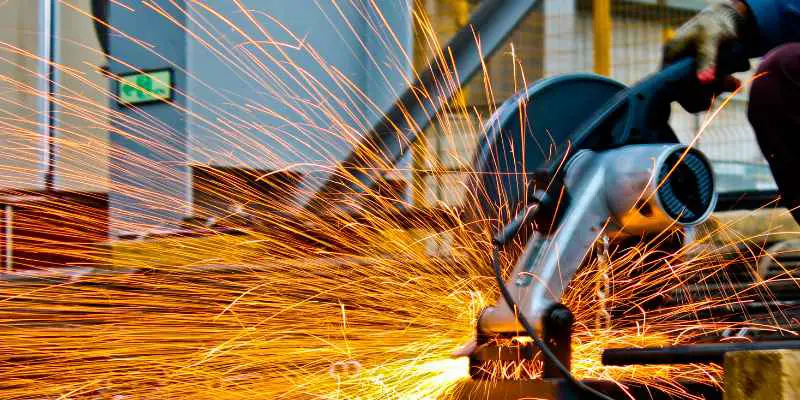Cut off saws are used for making straight cuts in metal or other materials, while miter saws are designed for making angled cuts in wood or plastic. These two types of saws serve different purposes and have distinct features that cater to specific cutting tasks.
Cutting tools are essential for various woodworking and metalworking projects. However, it’s crucial to choose the right tools for different cutting requirements. When it comes to straight cuts in metal or similar materials, a cut off saw is the go-to option.
On the other hand, for angled cuts mainly in wood or plastic, a miter saw is the ideal choice. Understanding the differences between these two types of saws will help you make informed decisions for your specific cutting needs. We will explore the characteristics, functions, and applications of both cut off saws and miter saws.
Cut Off Saw
A cut off saw, also known as a chop saw or abrasive saw, is a powerful tool designed for making quick, clean, and accurate cuts through various materials. It is commonly used in construction, metalworking, and woodworking projects. The main feature of a cut off saw is its abrasive cutting wheel, which rotates at high speed to cut through materials with ease. In this section, we will explore the functionality of a cut off saw, as well as its pros and cons.
Functionality
The primary function of a cut off saw is to cut through different materials with precision. It is especially useful for cutting through metal pipes, rods, and bars. The cutting wheel is made of abrasive material, such as aluminum oxide or silicon carbide, which enables it to grind through the material and create a clean and accurate cut. The saw is typically operated by pulling a trigger or pressing a button, which activates the motor and starts the spinning motion of the cutting wheel. The material to be cut is securely clamped in place, and the saw is then brought down onto the material to make the cut.
Pros And Cons
Here are the pros and cons of using a cut off saw:
| Pros | Cons |
|---|---|
| • Precise and accurate cuts | • Produces a lot of sparks and debris |
| • Fast cutting speed | • Can be noisy |
| • Versatile – cuts through various materials | • Requires proper safety precautions |
| • Can be used for both straight and angled cuts | • Limited cutting capacity |
One of the main advantages of using a cut off saw is its ability to make precise and accurate cuts. The cutting wheel allows for clean and straight cuts, making it ideal for projects that require precision. Additionally, the fast cutting speed of a cut off saw enables users to complete their cuts quickly, increasing efficiency. Another advantage is the versatility of the tool, as it can cut through various materials such as metal, wood, and plastic.
However, there are also some drawbacks to consider when using a cut off saw. One of the main concerns is the production of sparks and debris during cutting, which can be hazardous if proper safety precautions are not taken. The saw can also be quite noisy, so the use of hearing protection is recommended. Additionally, cut off saws have a limited cutting capacity, which may restrict their use for certain projects. Therefore, it is important to assess the specific requirements of your project before deciding to use a cut off saw.
In summary, a cut off saw is a powerful tool that offers precise and fast cutting capabilities. It is suitable for a range of materials and projects, but it is essential to be aware of the safety precautions and limitations associated with its use.

Miter Saw
A miter saw is a versatile cutting tool that is designed to make quick and accurate angle cuts. Due to its ability to pivot the blade from side to side, it is commonly used for cutting bevels, miters, and compound angles. This makes it an essential tool for a variety of woodworking, carpentry, and DIY projects.
Functionality
A miter saw is designed to make precise angle cuts, making it ideal for cutting crown molding, picture frames, and other materials that require accurate angled cuts. It can pivot left and right to create miter cuts and tilt the blade to create bevel cuts. Additionally, some miter saws have a sliding feature, allowing them to cut wider boards.
Pros And Cons
Below are the pros and cons of using a miter saw:
- Pros:
- Ability to make precise angle cuts
- Versatile for various cutting applications
- Efficient for cutting accurate angles quickly
- Cons:
- Requires space for operation and storage
- Not suitable for rip cuts or long straight cuts
- Can be more expensive than other cutting tools
Key Factors To Consider
When deciding between a cut-off saw and a miter saw, it is important to consider the type of materials you will be cutting, the precision needed, and the workspace available. The cut-off saw is suitable for heavy-duty and larger materials, while the miter saw allows for precise angle cuts and is ideal for woodworking projects.
Consider the specific needs of your project before making a decision.
When choosing between a cut off saw and a miter saw, several key factors must be considered to ensure that you select the right tool for your specific needs. By evaluating the type of cuts needed, accuracy requirements, portability, and material and blade compatibility, you can make an informed decision that will enhance the efficiency and precision of your cutting operations.
Type Of Cuts Needed
The type of cuts required for your projects plays a crucial role in determining whether a cut off saw or a miter saw is more suitable for your needs. If you primarily need to make straight cuts in materials such as metal, concrete, or masonry, a cut off saw might be the better choice. Conversely, if your projects involve versatile cutting angles and precise miter or bevel cuts, a miter saw would be the more appropriate option.
Accuracy Requirements
The level of precision and accuracy needed for your cutting tasks is another essential consideration. If your projects demand high precision, such as in woodworking or finish carpentry, a miter saw with its ability to make angled cuts with accuracy would be the preferred choice. On the other hand, if your work involves primarily rough cuts or basic shaping of materials, a cut off saw could meet your needs.
Portability
The portability of the saw is a crucial factor, especially for contractors and DIY enthusiasts who need to transport their tools to various job sites. A miter saw, typically designed with a compact and lightweight construction, offers higher portability, making it easier to move from one location to another. In contrast, cut off saws are generally larger and heavier, which can affect their portability.
Material And Blade Compatibility
Consider the types of materials you will be cutting and the compatibility of the saw’s blades. A cut off saw is often designed for cutting through tough materials like metal and concrete, making it suitable for heavy-duty applications. Conversely, a miter saw is more versatile in terms of blade options and can accommodate various types of blades designed for specific materials and cutting applications.
By carefully evaluating these key factors, you can determine whether a cut off saw or a miter saw aligns with your specific cutting needs, ensuring that you invest in the right tool for your projects.
Safety Precautions
Proper Gear
When using cut off saws or miter saws, it is crucial to wear appropriate safety gear to protect yourself from potential hazards. Make sure to always wear safety goggles to shield your eyes from flying debris and ear protection to minimize noise exposure. Don’t forget to use dust masks to avoid inhaling harmful particles.
Work Area Safety Measures
Creating a safe work environment is essential to prevent accidents when operating cut off saws or miter saws. Here are some important safety measures to consider:
- Clear the work area: Remove any unnecessary objects, clutter, or obstacles that may cause accidents while working.
- Provide ample lighting: Ensure the work area is well lit to enhance visibility and reduce the chances of errors or mishaps.
- Secure the workpiece: Always secure the workpiece firmly before making any cuts to prevent it from moving or falling during the operation.
- Use a stable work surface: Make sure your workspace is stable and steady to prevent accidents or vibrations that may affect your control over the tool.
Remember, maintaining a safe work area significantly reduces the risk of accidents, ensuring your protection and the safety of those around you.
Other Safety Precautions
In addition to proper gear and work area safety measures, here are a few other precautions to keep in mind:
- Read the user manual: Familiarize yourself with the manufacturer’s instructions and guidelines before operating any power tool.
- Double-check the tool: Ensure your cut off saw or miter saw is in good working condition with all safety features functional before use.
- Never force the tool: Let the tool do the work; do not apply excessive force or push the material too fast. This can lead to kickback or other accidents.
- Keep distractions at bay: Avoid any distractions while operating the tool to maintain focus and prevent potentially dangerous situations.
- Properly store the tools: After use, store your cut off saw or miter saw in a secure location, out of reach from children or unauthorized individuals.
By adhering to these safety precautions, you can ensure a safe and accident-free experience when using cut off saws or miter saws.
Cost Comparison
When considering whether to choose a cut off saw or a miter saw, one important factor to take into account is the cost comparison. Below, we’ll delve into the initial investment required, as well as the maintenance and operational costs associated with both types of saws. This information will help you make an informed decision based on your budget and long-term financial considerations.
Initial Investment
For some, the cut off saw may seem like a more cost-effective option upfront, but the miter saw typically offers more versatility and precision for its initial price.
Maintenance And Operational Costs
When it comes to maintenance and operational costs, miter saws tend to be more expensive due to the need for regular blade replacements and upkeep.
Best Applications
Industries
Construction, metalworking, fabrication, and woodworking industries benefit from the precision of both tools.
DIY Projects
- Cut off saws are ideal for making straight cuts in metal and other tough materials.
- Miter saws are perfect for creating angled cuts in wood for projects like picture frames.

Frequently Asked Questions For Cut Off Saw Vs Miter Saw
What Are The Main Differences Between A Cut Off Saw And A Miter Saw?
When choosing between the two saws, it’s important to understand their primary functions. A cut off saw is designed for straight cuts on materials like metal or concrete, while a miter saw specializes in angled cuts for woodworking projects.
Can A Cut Off Saw Be Used For Woodworking Projects?
A cut off saw is not the ideal tool for woodworking due to its straight cutting nature and the materials it is designed to work with. It is better suited for industrial and construction applications, such as cutting metal or concrete.
In What Woodworking Scenarios Would A Miter Saw Be A Better Choice Than A Cut Off Saw?
If your woodworking project involves making precise angled cuts, a miter saw is the superior choice. It is specifically crafted for creating bevel, miter, and compound cuts on wood, making it the perfect tool for framing, trim work, and other woodworking tasks.
Conclusion
Ultimately, the choice between a cut off saw and a miter saw depends on your specific needs and projects. While both tools are versatile and efficient, they excel in different areas. Consider the type of material you primarily work with, the range of angles you require, and the level of portability you desire.
By understanding the distinctions between these saws, you can make an informed decision and maximize productivity in your woodworking endeavors.


